Diese Seite ist mehrsprachig verfügbar: English, Русский, عربي.
Der historische Rundweg beginnt am Trinitatisplatz mitten in der Johannstadt. Sie erreichen den Trinitatisplatz mit der Straßenbahnlinie 6 aus Richtung Postplatz oder Niedersedlitz.
Vor 1945: Mitten in Johannstadt
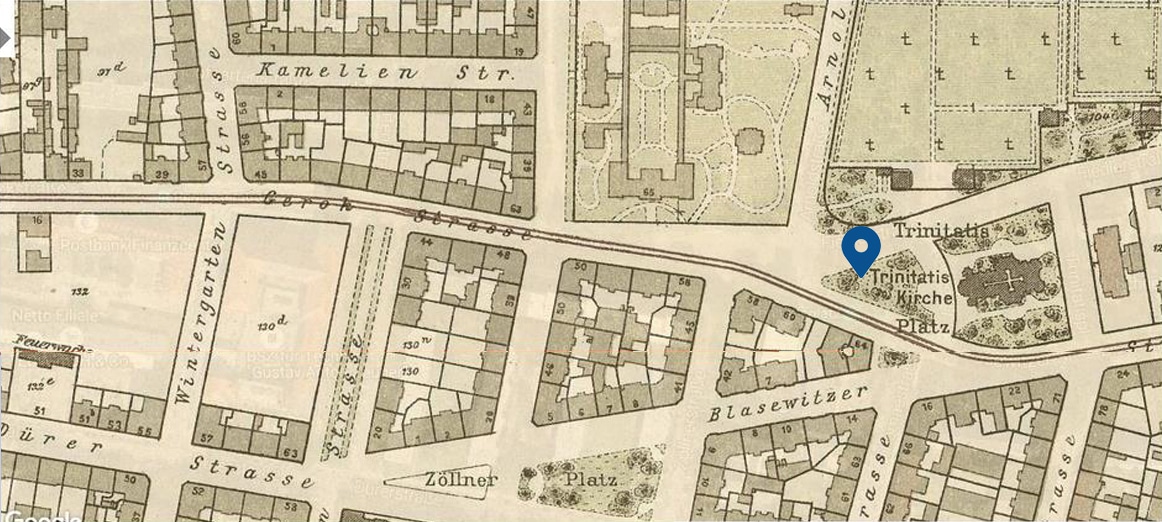
Trinitatisfriedhof
Durch Schließung des alten Johannisfriedhofes im Jahr 1814 musste ein neuer Begräbnisplatz außerhalb der Stadt gefunden werden. Die Wahl fiel auf die Grundstücke der kurz zuvor zerstörten Gaststätte „Engelhardts“ und das Spittelholz. Die Gestaltung der Anlage übertrug die Stadt 1815 dem Hofbaumeister Gottlob Friedrich Thormeyer. 1816 konnte die Anlage in Nutzung gehen und erhielt 1834 mit der Erweiterung den Namen Trinitatisfriedhof. In der Folgezeit wurden hier viele bekannte Persönlichkeiten bestattet, so u. a. der Arzt Carl Gustav Carus, der Maler Caspar David Friedrich, der Bildhauer Ernst Rietschel und die Sängerin Wilhelmine Schröder-Devrient. Nähere Informationen dazu sind auf dem Friedhof erhältlich. Neben dem Trinitatisfriedhof befindet sich der Neue Israelitische Friedhof, der ebenfalls zugänglich ist.
Weitere Informationen zur Geschichte des Trinitatisfriedhofs finden Sie hier.

Trinitatiskirche
[lat. trinitatis] steht in der christlichen Kirche für die Dreifaltigkeit von Gottvater, Gottes Sohn (Jesus) und Heiligem Geist.
Bedingt durch die Kriegsentschädigungen aus dem Deutsch-Französischen Krieg von 1870/71, die fortschreitende Industrialisierung und die geänderten Bauvorschriften setzte in Dresden eine spürbar verstärkte Bautätigkeit ein. Dies betraf auch die bis dahin ländlich geprägte Gegend der späteren Johannstadt. Felder und Gärten verschwanden zugunsten großer Karrees mit Wohnbebauung und Kleingewerbe in den Hinterhöfen, Fabriken siedelten sich an.
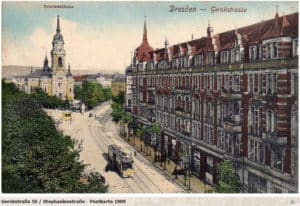
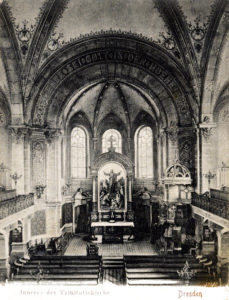
Die neuen Einwohner dieses Gebietes gehörten zur 1878 gegründeten Johannesgemeinde, die ursprünglich ihren Sitz an der Johanneskirche am heutigen St. Benno-Gymnasium hatte und bei der Weihe der Kirche 23.000 Gläubige zählte. Sechs Jahre später zählte die Gemeinde 40.000 Mitglieder – dafür war die Kirche zu klein. Mit dem Beschluss, der Johannstadt eine eigene Gemeinde zuzuordnen, entstand der Wunsch nach einem Kirchenneubau an einem zentralen städtebaulichen Punkt. Für diesen Zweck schenkte der Stadtrat der 1888 neu gegründeten Trinitatisgemeinde ein Grundstück am Trinitatisfriedhof. Nach mehreren vorausgehenden Planungen erhielt der ortsansässige Architekt Karl Barth den Zuschlag für die Planung eines Kirchenneubaus auf diesem Flurstück. 1894 konnte die Kirche im Stil der Neo-Renaissance mit dem 65 m hohen stadtbildprägenden Turm nach dreijähriger Bauzeit feierlich eingeweiht werden.
Weitere Informationen zur Geschichte der Trinitatiskirche finden Sie hier.
Trinitatisstraße
In der Trinitatisstraße (heutige Fiedlerstraße) befanden sich eine Reihe interessanter Bauwerke und Einrichtungen. So diente das Haus Nr. 2 als Bildhaueratelier der Kunstgewerbeschule, in dem unter anderem der Dresdner Bildhauer Selmar Werner (Trägerfiguren am Ständehaus, Schillerdenkmal auf dem Albertplatz, Kreuzigungsgruppe an der ehemaligen Englischen Kirche u.a.) tätig war. Auch die Dresdner Zigarettenindustrie hatte in dieser Straße zwei große Werke. Die Zigarettenfabriken Kios und Josetti erreichten deutschlandweite Bekanntheit. Lippolds Kofferfabrik produzierte in der Trinitatisstraße. Dieses kleine Werk hat vor allem durch seine Erwähnung in Erich Kästners 1957 veröffentlichtem Roman „Als ich ein kleiner Junge war“ Bekanntheit erlangt – hier war Kästners Vater angestellt. Der Grundstein für das nach 1945 gegründete VE Backwarenkombinat Dresden bestand in der hier ansässigen Brotfabrik. Der Großteil der Fabriken wurde bei der Bombardierung 1945 zerstört. Nur eine Fabrikantenvilla in der Blasewitzer Straße 9 ist noch erhalten.
Weitere Informationen zur Geschichte der Trinatisstraße finden Sie hier.
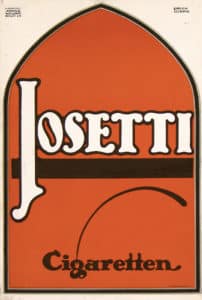
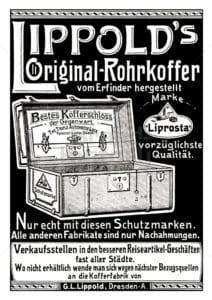
Nach 1945: Von der Ruine zur Jugendkirche
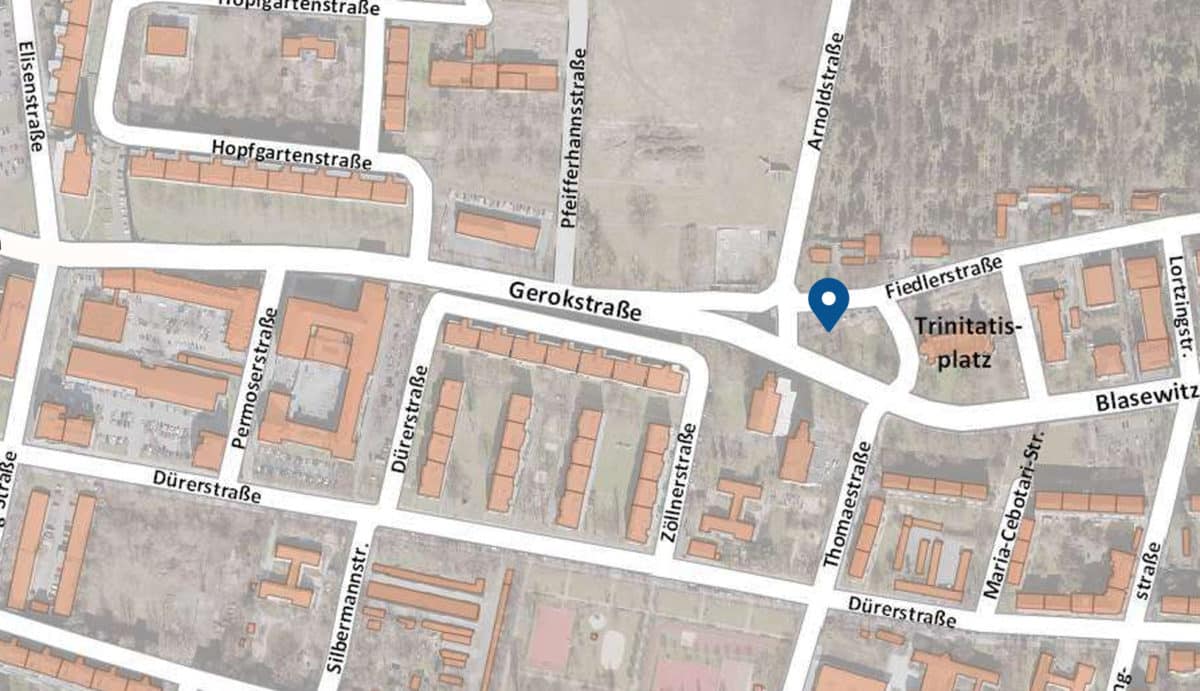
Trinitatiskirchruine
Bei den Bombardierungen im Februar 1945 brannte das Kirchenschiff der Trinitatiskirche nach nur 51 Jahren Nutzung völlig aus. Schwere Beschädigungen erlitten die Umfassungsmauern und das gegenüberliegende Gemeindehaus. Dachstuhl und Innenausstattung der Kirche gingen verloren. Einzig der Turm überstand den Bombenangriff relativ unbeschadet. Mit Beginn der Großflächenenttrümmerung in der Johannstadt Mitte der 1950er Jahre beräumte man das ehemals dicht bebaute, jetzt aber völlig zerstörte Umfeld der Kirche. Im wieder aufgebauten Gemeindehaus fand ein kirchlicher Kindergarten Platz.
Um den drohenden Abriss der Ruine Ende der 1960er Jahre zu verhindern, entwickelten die Gemeindemitglieder ein Projekt für einen Gottesdienstraum und eine Tagungsstätte. Sie enttrümmerten mit den einfachsten Mitteln in ihrer Freizeit die Ruine, sicherten die Mauerreste und den Turm. Bedingt durch fehlende finanzielle Mittel für den Abriss und den schließlich darin befindlichen kirchlichen Bauhof blieb die Ruine erhalten. Bis 2019 fanden hier regelmäßig Gottesdienste und Konzerte sowie kulturelle Veranstaltungen unter freiem Himmel statt. Die Räume im Turm wurden seit 1992 vor allem durch den Jugendtreff Trini für die von der Landeshauptstadt Dresden unterstützte offene Jugendarbeit genutzt. Von 1996 bis 2022 engagierte sich der Förderverein für den schrittweisen Ausbau der Ruine.
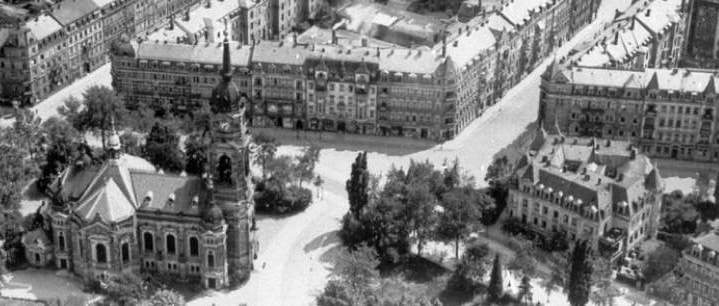
Vogelperspektive auf die Trinitatiskirche mit Bebauung um 1930. Etwa an Stelle des einzelstehenden Gebäudes rechts befinden sich jetzt die beiden Hochhäuser. Die von Bildmitte nach rechts unten wegführende Straße ist die Gerokstraße. Foto: unbekannt, aus der Sammlung JohannStadtArchiv
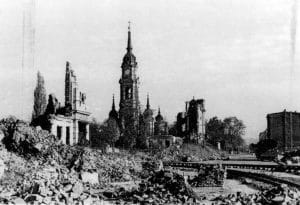
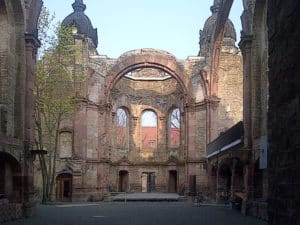
Jugendzentrum Jugendkirche Dresden
In Trägerschaft der Ev.-Luth. Kirchenbezirke Dresden Mitte und Dresden Nord erfolgte von 2019 bis 2021 mit Förderung aus dem Europäischen Fonds für Regionale Entwicklung (EFRE) und Mitteln der Landeshauptstadt Dresden der Ausbau der Ruine zum Jugendzentrum Jugendkirche Dresden. Seit 2021 finden hier Jugendliche aus dem Quartier und dem gesamten Stadtgebiet inspirierende Erlebnis- und Erfahrungsräume. Sie können hier selbst gestalten, miteinander diskutieren, eigene Ausdrucksformen finden und verschiedene Veranstaltungsformate erleben. Neben einem großen multifunktionalen Veranstaltungsraum finden im neuen Haus der bereits bestehende Jugendtreff Trini und nun auch die Geschäftsstelle der Evangelischen Jugend Dresden ihren Platz.
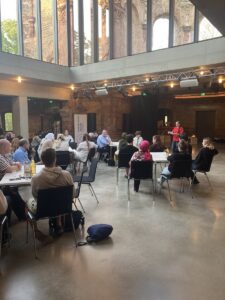
Weitere Informationen zur Jugendkirche finden Sie hier.
Text: Matthias Erfurth, Matthias Kunert, Henning Seidler
Redaktionsschluss: Januar 2024
